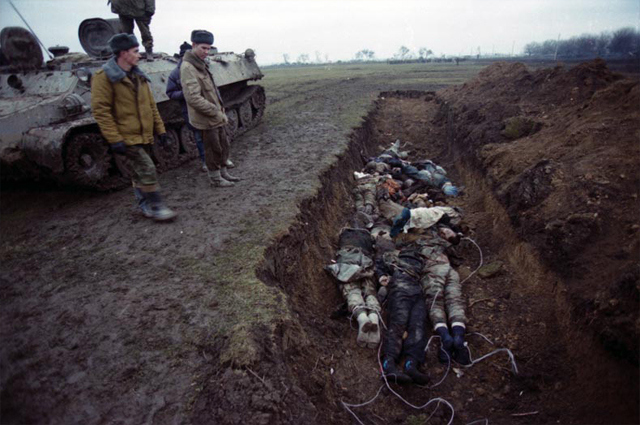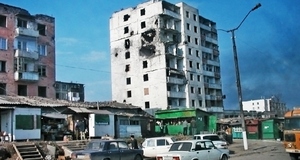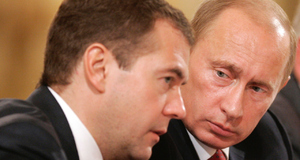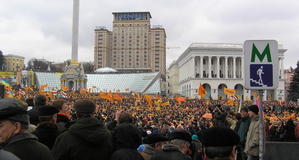|
From Cornell International Affairs Review VOL. 6 NO. 1 Campaign of Devastation: Assessing Motives for the Russian Government's 1999-2000 Destruction of Chechnya
By Laura Resnick
Cornell International Affairs Review
2012, Vol. 6 No. 1 | pg. 2/2 | «
I argue that the main motivation behind the 1999-2000 offensive was its assumed precedent-setting value and reputational benefits. However, I posit the secondary consideration that the Russian government wanted to use a strategy of extreme force in order to crush the rebel movement and undermine civilian support for the rebel movement. While I place this hypothesis secondary to my main normative hypothesis, I nonetheless believe that it represents an important facet in the Russian government’s choice to act in such a brutal manner.
Valentino notes that fighting a counterinsurgency campaign is in itself an incentive for mass killing and states, “…regimes seeking to defeat major guerrilla insurgencies may be drawn to strategies of mass killing” because of the nature of insurgencies.27 Putin was facing a largely guerilla-based campaign, with militant groups striking Russian targets. Because the civilian population was much more readily available than the insurgent force, Putin and the Russian government had an incentive to attempt to defeat the insurgency by killing off all of its support, since it was a logistically easier maneuver.28
Civilians were not able to hide, and most of them were defenseless against Russian bombing and shelling. As Valentino predicts, this strategy did in fact lead to mass killing of Chechen residents; the Chechen people were easy targets for a government with enough air power to carry on such warfare, and the Russian government likely felt that there was no viable military alternative that would preserve their vital interests.29
The Russian government’s strategy was likely bolstered by various examples of how overwhelming force could effectively be used to crush an insurgency, or at least to win battles in a conflict. One example that the Russian government likely drew on was the Soviet invasion of Afghanistan in the 1980s. Valentino postulates that even though the Afghan strategy was not a complete success, the Russians probably decided that there lacked a viable alternative for the Chechen situation.30
Jason Lyall’s study of Russian troops’ shelling and its impact on subsequent insurgent attacks surprisingly concluded that such massive violence actually reduced the number of insurgent attacks, rather than inspiring the rebels to attack more heavily.31 Therefore, the early devastation provided an incentive to continue that level of violence, because it appeared to be serving Russians’ strategic interests.
There are instances of Russian leaders explicitly expressing their desire to use force to crush the insurgent movement. On October 27, 1999, news reports relayed televised comments by Viktor Kazantsev, head of the federal forces in Chechnya, in which he stated, “taking Grozny is not the point, the aim is to free Chechen territory of the terrorist bands. They must realize they have just two options -- to lay down their arms or to be destroyed.”32 Other Russian leaders also spoke out on the strategic purpose of the violence. Before the campaign’s start, Putin himself expressed in earnest that the Russian military would “…deliver strikes against any place where gunmen are based [in Chechnya]… we will destroy the gunmen.”33
Examining the alternative military strategies available, it is easy to see why the Russian government settled on a strategy based on artillery and air power. The first phase of the conflict was considered a loss for the Russians and was marked by especially poor performance in urban combat, especially in Groznyy. This was probably a factor in the Russian military’s choice to use bombing and shelling as a means of attack – it could be carried out from far away, but it was necessarily more indiscriminate than using ground forces to take a city.
As Michael Coffy posits, “the Russian military learned to use brute force in the second Chechen war because it did not have a military that was capable of conducting a modern ‘bloodless’ war.” 34 As was previously noted, the Russian military did not possess precision munitions, only more indiscriminate weapons, which placed limits on how much they could avoid targeting civilians. Since the Russian military had no other viable strategic options, they were left with little choice to how they would rout the insurgents if they wanted to minimize Russian casualties while ensuring a cease to the insurgency.
The stakes were high enough that the Russian military could not take any chances with the campaign – they risked terrorist strikes on their homeland, as well as the threat of the secession of other parts of the Russian Federation if the Chechen separatists were successful. Therefore, the Russian military possessed many strategic incentives to utilize a campaign of destruction. On a theoretical level, the nature of the enemy meant that the use of massive violence against civilians was likely. On a practical level, the Russian military may not have had the ability or resources to conduct the campaign in any other way, given the stakes of losing. It was better for them to raze Groznyy than to risk protecting Chechen civilians at the expense of the safety and territorial integrity of the homeland.
The Russian military wanted, as its ultimate aim, to crush the separatist movement. They could have done this by wiping out the rebels, starving them of support, or convincing them to give up their struggle. One way of achieving the aim of convincing the rebels to surrender their cause could have been to render the territory so devastated that the rebels faced little incentive to secede.

A mass grave in Chechnya
Chechnya’s destruction was so severe that repair of the region was likely inconceivable without financial support from the Russian central government. Chechnya was still reeling from the first phase of the conflict when the second phase commenced; a state budget had not existed since 1992, the collection of taxes had ceased and so Chechnya did not get its expected share of oil revenue, and in 1999 the region’s oil output had dropped to 400 tons per day, compared to 4,200 tons in 1998.35
In 2002, the UN named Groznyy the “most destroyed city on the planet.”36 Indeed, in 2000, the Russian government did pledge to provide support for Chechnya through the UN.37 Later, according to a January 29, 2001 news report by Agence France- Presse, Russia provided $514 million dollars worth of aid to Chechnya in 2001. In 2009, nine years after the Russian offensive, the Russian government was still pumping hundreds of millions of dollars into Chechen reconstruction.38 Had the separatists succeeded, it is unclear how they would have managed to rebuild without such funding, especially given that Chechen employment continued to be extraordinary – in 2009, Chechen unemployment levels remained over fifty percent.39
Russian government officials must have been aware of the region’s financial situation, and thus could have chosen to take advantage of it by creating even more weakness through gratuitous destruction and engendering dependence on Russian aid for rebuilding purposes. The need for funding would have been a powerful incentive to give up hope of independence, as otherwise, the Chechens would have simply seceded to a pile of rubble, hopeless to rebuild. The challenges of nation-building in post-conflict societies are great enough without having to physically rebuild a country from the ground up. It is entirely plausible that if the Chechens had succeeded in their quest for independence, the devastation wrought by the Russian attacks would have forced them back to Moscow shortly after independence because the financial strain of nation-building would be too large a barrier to overcome.
This argument, while logically plausible, currently suffers from a lack of supporting evidence. The evidence presented in support of this hypothesis could be used to support my other hypotheses, or could simply be written off as tallies of the destruction wrought as a side effect of a brutal military campaign carried out for the aforementioned normative and strategic reasons. Unfortunately, it is almost impossible to discern whether this desire motivated the Russian military based on the available evidence. Therefore, this hypothesis remains only theoretically plausible until such time as it can be either confirmed or denied. Nonetheless, I offer it as a potential alternative or supplement to my main normative and strategic hypotheses, supported by the circumstantial evidence offered above.
The Russian attack on Chechnya from 1999-2000 was horrific. It left between 8,606 and 17,377 people dead, making it the two deadliest years of the entire conflict. It destroyed infrastructure, families, and an entire region. As former president Mikhail Gorbachev stated, “there were many guilty parties in this war, and history will put everything in its place. But the human lives lost cannot be brought back, and the destruction is difficult to reverse.”
This paper has put forth three potential motivations for Russia’s violence in Chechnya: Putin’s desire to restore the reputation of Russia, prevent other groups in Russia from considering secession, and further his own political career; the Russian government’s desire to find an effective way of combating the insurgent movement given their limited military capacity; and finally the Russian military’s desire to devastate Chechnya so that the rebels had reduced incentives to secede, given that their territory would be irreparably damaged. While this paper points to the normative, reputation-enhancing aspect of the extreme violence, it also implicates the second and third factors as contributing to the decision to use overwhelming force.
The odds, both circumstantial and strategic, were against the Chechen civilians. Because of the situation in which history and politics had placed them, over 17,000 Chechens lost their lives. In the end, Russia superficially achieved its stated goal of silencing the insurgency. However, in actuality, the rebellion lives on in the present movement to unite the Caucuses. While it is too late to save Chechnya from destruction, it is not too late for the international community and domestic political actors to understand the context historical events and the motivations of the Russian government.
Learning from Chechnya’s horror, the international community can reduce the amount of regions and groups that will have to experience such campaigns of destruction brought upon them by the government. With luck, international actors can fashion a world in which innocent civilians will no longer experience what it is like to struggle to live in and sometimes die in “a small corner of Hell.”
- Stathis N. Kalyvas, “Wanton and Senseless? The Logic of Massacres in Algeria,” Rationality and Society vol. 11 no. 3 (1999), 243-285.
- Commission on Security and Cooperation in Europe, “Hearing on Chechnya” (Washington DC: US Government Printing Office, 1995).
- Anna Politkovskaya, “A Small Corner of Hell: Dispatches from Chechnya,” (Chicago: University of Chicago Press, 2003).
- Upsalla Conflict Data Program, “Russia,” accessed March 1 2012. http://www.ucdp.uu.se/gpdatabase/gpcountry.php?id=132®ionSelect=9-Eastern_Europe#
- Anna Politkovskaya, “A Small Corner of Hell: Dispatches from Chechnya.”
- Upsalla Conflict Data Program, “Russia,” accessed March 1 2012.
- Jason Lyall, “Does Indiscriminate Violence Incite Insurgent Attacks?” in The Journal of Conflict Resolution vol. 53 no. 3 (June 2009), 339.
- US Country Report on Human Rights, Russia, 1999, US Department of State.
- US Country Report on Human Rights, Russia, 1999, US Department of State. Note that the figure of 116 deaths was quoted by the Chechen government, which had incentive to over-represent the number of casualties in the offensive.
- “Warplanes Carry out 150 Sorties in Chechnya in Past 24 Hours,” Interfax, October 28, 1999.
- US Country Report on Human Rights, Russia, 1999, US Department of State.
- US Country Report on Human Rights, Russia, 2000, US Department of State.
- Thornike Gordadze, “Chechnya: Eradication of the Enemy Within” in In the Shadow of Just Wars: Violence, Politics and Humanitarian Action ,(Cornell University Press, 2004), 189.
- Debidatta Mahapatra and Seema Shekhawat, “Conflict in Kashmir and Chechnya: Political and Humanitarian Dimensions” (Lancer’s Books, 2007), 70-71.
- “Russia’s Yeltsin Resigns, Names Prime Minister Putin Acting President” in Dow Jones Business News, December 31 1999.
- Thornike Gordadze, “Chechnya: Eradication of the Enemy Within,” 184.
- Barbara Walter “Reputation and Civil War: Why Separatist Conflicts are so Violent” (New York: Cambridge University Press, 2009), 8-9.
- Monica Toft, “Indivisible Territory, Geographic Concentration, and Ethnic War” in Security Studies vol. 12 no. 2 (winter 2002/2003), 84.
- Barbara Walter “Reputation and Civil War: Why Separatist Conflicts are so Violent” 22.
- Minorities at Risk, “”Data,” published 31 December 2006, accessed April 24 2012. http://www.cidcm.umd.edu/mar/assessments.asp?regionId=2
- Barbara Walter “Reputation and Civil War: Why Separatist Conflicts are so Violent” 26.
- Benjamin Valentino, Final Solutions: Mass Killing and Genocide in the 20th Century (Cornell University Press, 2004), 2.
- Jamie Walker, “Putin’s Bloody Stepping Stone” The Australian, December 11, 1999.
- Levada Center – Russia Votes Project, “International Security - Trends,” updated on March 1 2012, accessed on April 24 2012. http://www.russiavotes.org//security/security_trends.php#476
- Derek Chollet and James Goldgeier, “America Between the Wars: From 11/9 to 9/11” (New York: Council on Foreign Relations, 2008), 232.
- Benjamin Valentino, “Final Solutions: Mass Killing and Genocide in the Twentieth Century” 5.
- Ibid
- Ibid., 82.
- Ibid., 233.
- Jason Lyall, “Does Indiscriminate Violence Incite Insurgent Attacks?: Evidence from Chechnya” in Journal of Conflict Resolution vol. 53 no. 3 (June 2009): 357.
- Alkha Tosuyev, “Russians Push to Chechen Capital,” Reuters, October 27, 1999.
- Nikolai Topuria, “Russia Opens Offensive in Dagestan, Warns of Strikes Agaisnt Chechnya,” Agence France-Presse, August 13 1999.
- Michael Coffy, “Military Learning Between the Chechen Wars” in Vestnick: The Journal of Russian and Asian Studies (2006). Note: taken from a masters-level work.
- Valery Tishkov, “Chechnya: Life in a War-Torn Society,” (Berkley: University of California Press, 2004), 188.
- Rupert Wingfield-Hayes, “Chechen Problem Far From Over,” BBC Moscow, April 6 2009.
- BBC, “Russia Promise on Chechnya Aid,” January 28 2000.
- Rupert Wingfield-Hayes, “Chechen Problem Far From Over,” BBC Moscow, April 6 2009.
- Rupert Wingfield-Hayes, “Chechen Problem Far From Over,” BBC Moscow, April 6 2009.
Endnotes
- Stathis N. Kalyvas, “Wanton and Senseless? The Logic of Massacres in Algeria,” Rationality and Society vol. 11 no. 3 (1999), 243-285.
- Commission on Security and Cooperation in Europe, “Hearing on Chechnya” (Washington DC: US Government Printing Office, 1995).
- Anna Politkovskaya, “A Small Corner of Hell: Dispatches from Chechnya,” (Chicago: University of Chicago Press, 2003).
- Upsalla Conflict Data Program, “Russia,” accessed March 1 2012. http://www.ucdp.uu.se/gpdatabase/gpcountry.php?id=132®ionSelect=9-Eastern_Europe#
- Anna Politkovskaya, “A Small Corner of Hell: Dispatches from Chechnya.”
- Upsalla Conflict Data Program, “Russia,” accessed March 1 2012.
- Jason Lyall, “Does Indiscriminate Violence Incite Insurgent Attacks?” in The Journal of Conflict Resolution vol. 53 no. 3 (June 2009), 339.
- US Country Report on Human Rights, Russia, 1999, US Department of State.
- US Country Report on Human Rights, Russia, 1999, US Department of State. Note that the figure of 116 deaths was quoted by the Chechen government, which had incentive to over-represent the number of casualties in the offensive.
- “Warplanes Carry out 150 Sorties in Chechnya in Past 24 Hours,” Interfax, October 28, 1999.
- US Country Report on Human Rights, Russia, 1999, US Department of State.
- US Country Report on Human Rights, Russia, 2000, US Department of State.
- Thornike Gordadze, “Chechnya: Eradication of the Enemy Within” in In the Shadow of Just Wars: Violence, Politics and Humanitarian Action ,(Cornell University Press, 2004), 189.
- Debidatta Mahapatra and Seema Shekhawat, “Conflict in Kashmir and Chechnya: Political and Humanitarian Dimensions” (Lancer’s Books, 2007), 70-71.
- “Russia’s Yeltsin Resigns, Names Prime Minister Putin Acting President” in Dow Jones Business News, December 31 1999.
- Thornike Gordadze, “Chechnya: Eradication of the Enemy Within,” 184.
- Barbara Walter “Reputation and Civil War: Why Separatist Conflicts are so Violent” (New York: Cambridge University Press, 2009), 8-9.
- Monica Toft, “Indivisible Territory, Geographic Concentration, and Ethnic War” in Security Studies vol. 12 no. 2 (winter 2002/2003), 84.
- Barbara Walter “Reputation and Civil War: Why Separatist Conflicts are so Violent” 22.
- Minorities at Risk, “”Data,” published 31 December 2006, accessed April 24 2012. http://www.cidcm.umd.edu/mar/assessments.asp?regionId=2
- Barbara Walter “Reputation and Civil War: Why Separatist Conflicts are so Violent” 26.
- Benjamin Valentino, Final Solutions: Mass Killing and Genocide in the 20th Century (Cornell University Press, 2004), 2.
- Jamie Walker, “Putin’s Bloody Stepping Stone” The Australian, December 11, 1999.
- Levada Center – Russia Votes Project, “International Security - Trends,” updated on March 1 2012, accessed on April 24 2012. http://www.russiavotes.org//security/security_trends.php#476
- Derek Chollet and James Goldgeier, “America Between the Wars: From 11/9 to 9/11” (New York: Council on Foreign Relations, 2008), 232.
- Benjamin Valentino, “Final Solutions: Mass Killing and Genocide in the Twentieth Century” 5.
- Ibid
- Ibid., 82.
- Ibid., 233.
- Jason Lyall, “Does Indiscriminate Violence Incite Insurgent Attacks?: Evidence from Chechnya” in Journal of Conflict Resolution vol. 53 no. 3 (June 2009): 357.
- Alkha Tosuyev, “Russians Push to Chechen Capital,” Reuters, October 27, 1999.
- Nikolai Topuria, “Russia Opens Offensive in Dagestan, Warns of Strikes Agaisnt Chechnya,” Agence France-Presse, August 13 1999.
- Michael Coffy, “Military Learning Between the Chechen Wars” in Vestnick: The Journal of Russian and Asian Studies (2006). Note: taken from a masters-level work.
- Valery Tishkov, “Chechnya: Life in a War-Torn Society,” (Berkley: University of California Press, 2004), 188.
- Rupert Wingfield-Hayes, “Chechen Problem Far From Over,” BBC Moscow, April 6 2009.
- BBC, “Russia Promise on Chechnya Aid,” January 28 2000.
- Rupert Wingfield-Hayes, “Chechen Problem Far From Over,” BBC Moscow, April 6 2009.
- Rupert Wingfield-Hayes, “Chechen Problem Far From Over,” BBC Moscow, April 6 2009.
Save Citation » (Works with EndNote, ProCite, & Reference Manager)
APA 6th
Resnick, L. (2012). "Campaign of Devastation: Assessing Motives for the Russian Government's 1999-2000 Destruction of Chechnya." Cornell International Affairs Review, 6(1). Retrieved from http://www.inquiriesjournal.com/a?id=1212
MLA
Resnick, Laura. "Campaign of Devastation: Assessing Motives for the Russian Government's 1999-2000 Destruction of Chechnya." Cornell International Affairs Review 6.1 (2012). <http://www.inquiriesjournal.com/a?id=1212>
Chicago 16th
Resnick, Laura. 2012. Campaign of Devastation: Assessing Motives for the Russian Government's 1999-2000 Destruction of Chechnya. Cornell International Affairs Review 6 (1), http://www.inquiriesjournal.com/a?id=1212
Harvard
RESNICK, L. 2012. Campaign of Devastation: Assessing Motives for the Russian Government's 1999-2000 Destruction of Chechnya. Cornell International Affairs Review [Online], 6. Available: http://www.inquiriesjournal.com/a?id=1212
Suggested Reading from Inquiries Journal
The Republic of Chechnya in Russia’s North Caucasus region has drawn significant attention for being host to remarkable instability, thriving terrorism, and a staggering display of human rights violations over the past two decades, including torture, illegal imprisonment, and extrajudicial execution. Perhaps even more disturbing... MORE»
When on September 24th, 2011 Russian prime minister Vladimir Putin announced his bid to run for president in the presidential elections in March 2012, a supposition in Russia's political regime was confirmed that many... MORE»
The Chechen people have endured a long history of aggression, culminating at the end of the twentieth century during which a separatist struggle against Russia began, triggering the First Chechen War in 1994. At the onset of the Second Chechen War however, it became apparent that Chechens were engaging in a different kind of warfare. In September of 1999, over 300 people were killed when Chechen terrorists destroyed apartment complexes in Moscow,... MORE»
The responsibility of Georgian President Michael Saakashvili for the war with Russia continued to be hotly debated in Georgia, Russia and the world several months after its end.1 Indeed, there are various views about Saakashvili... MORE»
Latest in Political Science
2022, Vol. 14 No. 09
This interdisciplinary paper investigates the shortfalls and obstacles to success currently facing the climate movement, examining issues represented by the disconnect between policy and electoral politics, the hypocrisy and blatant indifference... Read Article »
2022, Vol. 14 No. 06
Two of the most prevalent protest movements in recent history were the Black Lives Matter and the #StopTheSteal movements. While there are many differences between the two, one of the most prevalent is their use of violence. Whereas the BLM movement... Read Article »
2022, Vol. 14 No. 05
Strong linkages between autocrats and the military are often seen as a necessary condition for authoritarian regime survival in the face of uprising. The Arab Spring of 2011 supports this contention: the armed forces in Libya and Syria suppressed... Read Article »
2022, Vol. 14 No. 04
During the summer of 2020, two fatal shootings occurred following Black Lives Matter protests. The first event involved Kyle Rittenhouse in Kenosha, Wisconsin, and the second Michael Reinoehl in Portland, Oregon. Two shootings, each committed by... Read Article »
2022, Vol. 14 No. 02
In popular international relations (IR) theory, knowledge production is often dismissed as an objective process between the researcher and the empirical world. This article rejects this notion and contends that the process of knowledge production... Read Article »
2022, Vol. 14 No. 01
This article explores the political relationship between nation-building, ethnicity, and democracy in the context of Ethiopia. It traces Ethiopia's poltical history, explores the consequential role ethnicity has played in the formation of the modern... Read Article »
2022, Vol. 14 No. 01
The study examines the degree to which Xi Jinping has brought about a strategic shift to the Chinese outward investment pattern and how this may present significant political leverage and military advantages for China in the Indian Ocean Region (... Read Article »
|



















